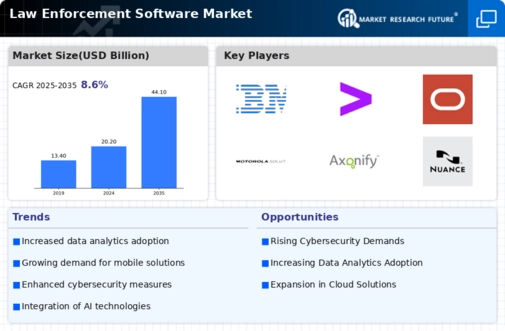Top Industry Leaders in the Law Enforcement Software Market

Law Enforcement Software Market: Dive into the Latest News and Updates
The fight against crime in the 21st century necessitates more than just badges and boots on the ground. Modern law enforcement relies heavily on a sophisticated arsenal of software solutions to enhance its operational efficiency, improve investigative capabilities, and ultimately bolster public safety.
Some of Law Enforcement Software Companies Listed Below:
- IBM (US)
- Accenture (Ireland)
- Oracle (US)
- Motorola Solutions (US)
- Axon (US)
- CyberTech (India)
- Nuance Communication (US)
- Esri (US)
- PTS Solutions (US)
- Palantir Technologies (US)
- eFORCE Software (US)
- Wynyard Group (US)
- DFLABS (Italy)
- ARMS (US)
- Hexagon Safety & Infrastructure (US)
- CODY Systems (US)
- Column Technologies (US)
- Cyrun (US)
- Incident Response Technologies (US)
- Numerica Corporation (US)
- Diverse Computing (US)
- Omnigo Software (US)
- Alert Public Safty Solutions (US)
- CAPERS (US)
- BlueLine Grid (US)
Strategic Maneuvers for Market Dominance:
Competition in this crucial market demands strategic agility. Key players are adopting strategies like:
-
Cloud-based Solutions: Embracing cloud-based software to offer cost-effective, easily scalable platforms for smaller agencies and improved data accessibility for collaboration. -
Data-Driven Insights: Integrating advanced analytics and AI capabilities to unlock actionable insights from crime data, enabling predictive policing and resource allocation optimization. -
Community Policing Emphasis: Developing software to facilitate data-driven outreach programs and collaborative initiatives with citizens, fostering trust and community engagement. -
Partnerships and Acquisitions: Forging strategic collaborations with technology giants and smaller developers to access new technologies, reach wider markets, and offer holistic solutions.
Market Share Analysis: Deciphering the Dynamics:
Understanding the Law Enforcement Software market share within this complex landscape requires careful consideration of several factors:
-
Product Portfolio Breadth: Offering comprehensive solutions catering to diverse needs, from patrol operations to intelligence gathering, holds an advantage. -
Scalability and Flexibility: Adapting to the technological and budget constraints of various agencies, from large urban forces to rural departments, is crucial. -
Regional Compliance Expertise: Navigating the intricate local and national data privacy regulations ensures compliance and fosters trust with authorities. -
Cybersecurity Robustness: Ensuring robust data security measures within software solutions is paramount for building trust and mitigating risks.
Emerging Stars on the Horizon:
Beyond established players, innovative startups are disrupting the market with:
-
AI-powered Crime Prediction: Leveraging AI to analyze crime patterns and predict potential hotspots, enabling proactive patrol allocation and crime prevention. -
Biometric Identification Solutions: Developing advanced facial recognition and other biometric identification tools to enhance suspect identification and improve investigative efficiency. -
Open-source Platforms: Offering cost-effective, customizable open-source platforms catering to agencies with limited budgets and fostering community-driven development.
Investment Trends Propelling Growth:
The Law Enforcement Software Market is attracting significant investment, fueled by:
-
Government Funding: Government initiatives to modernize law enforcement infrastructure and improve public safety are driving significant public investment in software solutions. -
Venture Capital Interest: Recognizing the market's potential, venture capitalists are increasingly backing promising startups offering innovative technologies. -
Strategic Partnerships: Collaborative ventures between software developers, system integrators, and managed service providers are opening up new funding opportunities and market access.
Latest Company Updates:
February 8, 2024:
-
Growing adoption of predictive policing tools: Utilizing AI and data analysis to anticipate crime patterns and allocate resources accordingly. -
Concerns about potential bias and lack of transparency in predictive algorithms.
February 15, 2024:
-
Rise of body-worn cameras (BWCs) with AI-powered features: Facial recognition, object detection, and automatic redaction for privacy protection. -
Debates around data storage, access, and potential misuse of BWC footage.
March 6, 2024:
-
Increased focus on virtual reality (VR) training simulators for realistic and immersive officer training. -
Questions about the effectiveness and potential for desensitization in VR training.
March 20, 2024:
-
Integration of law enforcement software with mental health resources: Connecting officers with specialists for de-escalation and crisis intervention. -
Emphasis on mental health awareness and training for officers.
April 3, 2024:
-
Focus on cybersecurity threats and vulnerabilities in law enforcement systems: Implementing robust safeguards against hacking and data breaches. -
Concerns about potential weaponization of data and privacy violations.

